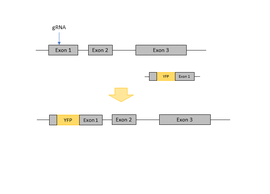Getting started
You want to establish a new mouse model with us? Please contact us via gene-editing@uni-bonn.de to arrange a first meeting where we can discuss your project ideas and figure out the method of choice for your needs.

Gene Editing

Step 1: Prepare gene-editing strategy

Step 2: Preparation and testing of CRISPR material

Step 2 (in parallel): Apply for ammentment of animal license

In the meantime, we will set-up a short addition to the animal license together, which we will submit to the local authority to receive the permission to generate the requested mouse line. The Core Facility describes the gene editing techniques to be applied and the methods used, scientific background and intended use of the newly generated mouse line is provided by the user.
Step 3: Embryo manipulation
Once the constructs are ready and the permission is granted, we will generate oocytes from your desired strain by super-ovulation and perform zygote manipulations. Developing (2-cell) embryos will be transferred into pseudo-pregnant foster mice.

Step 4: Identification of founder mice

After weaning of offspring from foster mothers, we will perform genotyping and hopefully identify gene-edited positive founder animals. For most founder mice, PCR genotyping is confirmed by sequencing of the whole modified region. Confirmed animals can then be transferred to your animal facility for further breeding.
Step 5: Backcrossing and confirmation genotyping
If you want us to do the first backcrossing of founder mice with wild type animals in our facility and repeat PCR and sequencing analyses on F1 offspring, this is also possible. This service is not included in the price calculations and will be invoiced separately.

Transgenic Services

For transgenic services like cryopreservation or embryo transfer, we would ask you to fill in our transgenic form (see below) which we send you upon request at gene-editing@uni-bonn.de. Please include the current health certificate of your mice for imports to the LIMES animal facility.
Please note, that for rederivation or embryo transfer of potentially burdened mouse lines, a small addition to the animal license of the core facility gene-editing has to be submitted to the local authorities (comparable to the one required for generation of a new line, see above) and the user has to apply for a seperate breeding license for the mouse line beforehand. Only when both permissions are granted burdened lines can be transferred or revitalized.
